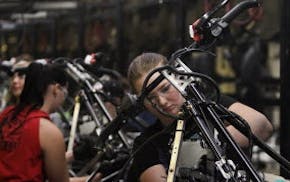An alliance formed by metro counties to expand light rail and fast busways is starting to fray.
Dakota County commissioners are questioning whether their taxpayers are getting enough back from the $14 million they pay each year.
"Most of the future projects — in dollars and cents — are heading toward the western metropolitan area,'' said Commissioner Tom Egan. "We are making sure that everyone knows that we want to be a good team player but at the same time we are not fools and we want to be treated fairly.''
Commissioners have not yet discussed the issue as a board. In individual interviews several commissioners said they are thinking about the arrangement.
The counties formed the transit board to create a regional system, said Dakota Commissioner Kathleen Gaylord. But, she said: "In the east side of the metropolitan area we are not getting quite the same investment that we see on the west side.
"I hate this east/west thing that we always seem to have," she said. "But look at any map and you see trains all over the west side and buses all over the east side.''
Hennepin County Commissioner Peter McLaughlin, a Democrat who chairs the coalition, said Dakota's own mixed-party politics have gotten in its way.
The county's Republican legislators opposed a rail route extending south from the Mall of America over the Minnesota River bridge on Cedar, he said. "They didn't get a train. They didn't ask for one. They got what they asked for.''
All the member counties have gotten a good deal, he added.
"In six years [we've] invested over half a billion to expand the transit system in the metro area. We have things going on in every one of our member counties. I think it's been an enormous success. Where would we be without it?''
Future projects questioned
At stake is the future of a six-year-old venture uniting Dakota with Hennepin, Anoka, Ramsey and Washington counties as the Counties Transit Improvement Board (CTIB).
Starting in 2008, legislators let them use proceeds from a quarter-cent sales tax and a $20 motor vehicle sales tax to advance projects of their choice.
The board helped finance the recently opened $1 billion Green Line light-rail line between Minneapolis and St. Paul. The same is true of the $112 million Red Line Bus Rapid Transit service, which opened in June 2013 on Cedar Avenue between Apple Valley and the Mall of America in Bloomington. Both drew unanimous support.
It's the projects next in line that are giving Dakota County pause.
A proposed Southwest light rail line from Minneapolis to Eden Prairie has a current price tag of $1.68 billion. The proposed Bottineau transitway through the northwest suburbs from Brooklyn Park to Minneapolis is estimated at $1 billion.
McLaughlin said that Dakota may be forgetting that Hennepin County was the only county contributor to the Hiawatha line, now being used by lots of Dakota residents at the Mall of America.
"We paid for all of the investment downtown and all the electronic controls and now people can build on that,'' McLaughlin said. Hennepin also put in nearly $300 million, or nearly a third the cost of the Green Line, he said.
The most recent figures available on the contribution of each county to the transit alliance shows that in 2012: Washington contributed about $6 million or just under 6 percent of the total; Anoka contributed about $9 million or just under 9 percent of the total; Dakota contributed $13 million or just over 12 percent of the total; Ramsey's contribution was about $18 million for about 17 percent of the total and Hennepin, the most populous county, put in about $58 million or 55 percent of the total.
Buses main transportation
Lacking the population density and ridership that is critical to attract billions for rail lines in the central cities and western suburbs, Dakota is being connected to the metro transit system by comparatively less expensive bus lines on Cedar Avenue and Interstate Hwy. 35W.
On Dakota's future wish list of transit improvements is a $14.6 million stop built in the freeway median on the Cedar busway to eliminate a slow trip off the freeway to the Eagan station that is hampering ridership.
On I-35W, Metro Transit plans to open bus rapid transit service from downtown Minneapolis to Lakeville in 2019. At some point, Dakota plans to extend the Red Line line south to Lakeville.
And it will pursue a transit upgrade for Robert Street in West St. Paul, although officials have not yet decided whether they prefer a $370 million streetcar line or a $27 million premium bus service.
"We are wide open to a streetcar,'' McLaughlin said. "We made a specific provision to allow a streetcar on Robert Street specifically to accommodate Dakota County."
Even if a streetcar is chosen, the cost of all Dakota projects combined are "relatively small potatoes," compared to billions that would be spent on the proposed southwest and northwest Hennepin County light-rail lines, Egan said.
A decision on Robert Street is expected later this summer and that could prompt a County Board discussion about whether to stay in the joint powers board. Or the board could talk about that when transit funding is addressed by the 2014 legislature, commissioners said.
If the county decides to withdraw from CTIB, rules would require Dakota to continue its tax support until all of the bonds issued by the group while the county was a member are paid off. But a withdrawal would end its commitment to provide tax support future projects.
Laurie Blake • 952-746-3287

Minnesota added thousands of jobs in March but worker shortage still an issue
Private prison van driver, accused of raping St. Paul woman he was transporting, gets 30 years for similar attacks

Shop the curbs for free on 'Trash to Treasure Day' in White Bear Lake
Longtime Uptown boutique closing in May

